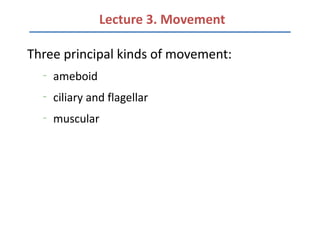
Lecture 3 movement 2nd sem 2008-2009
- 1. Lecture 3. Movement Three principal kinds of movement: – ameboid – ciliary and flagellar – muscular
- 2. Ameboid Movement – amebas and other unicellular forms – white blood cells – embryonic mesenchyme cells – other mobile cells
- 4. Fig. 11.5a
- 5. Fig. 11.5c
- 6. Consensus model to explain extension and withdrawal of pseudopodia and ameboid crawling: 1. hyaline cap appears
- 7. Consensus model to explain extension and withdrawal of pseudopodia and ameboid crawling: 2. endoplasm flows toward hyaline cap
- 8. Consensus model to explain extension and withdrawal of pseudopodia and ameboid crawling: 3. actin subunits attach to regulatory proteins
- 9. Consensus model to explain extension and withdrawal of pseudopodia and ameboid crawling: 4. endoplasm fountains out to the periphery
- 10. Consensus model to explain extension and withdrawal of pseudopodia and ameboid crawling: 5. actin subunits released and polymerized
- 11. Consensus model to explain extension and withdrawal of pseudopodia and ameboid crawling: 6. microfilaments cross-linked
- 12. Consensus model to explain extension and withdrawal of pseudopodia and ameboid crawling: 7. Ca2+ activate actin-severing protein
- 13. Consensus model to explain extension and withdrawal of pseudopodia and ameboid crawling: 8. myosin associate with and pull on microfilaments
- 14. Ciliary and Flagellar Movement Cilia – minute, hairlike, motile processes – occur in large numbers – ciliate protistans – found in all major groups of animals – move organisms through aquatic environment – propel fluids and materials across surfaces
- 16. Ciliary and Flagellar Movement Flagella – whiplike – present singly or in small numbers – occur in unicellular eukaryotes – animal spermatozoa – sponges
- 17. • both cilia and flagella have the same ultrastructure – a core of microtubules sheathed by the plasma membrane
- 18. • both cilia and flagella have the same ultrastructure – “9 + 2” pattern – flexible “wheels” of proteins connect outer doublets to each other and to the core
- 19. • both cilia and flagella have the same ultrastructure – outer doublets are connected by motor proteins – anchored in the cell by a basal body
- 20. • The bending of cilia and flagella is driven by the arms of a motor protein, dynein.
- 21. • Addition to dynein of a phosphate group from ATP and its removal causes conformation changes in the protein. • Dynein arms alternately grab, move, and release the outer microtubules.
- 22. • Protein cross-links limit sliding and the force is expressed as bending.
- 23. • A flagellum has an undulatory movement – force is generated parallel to the flagellum’s axis
- 24. • Cilia move more like oars with alternating power and recovery strokes – generate force perpendicular to the cilia’s axis
- 25. Invertebrate Muscle Bivalve molluscan muscles – 2 kinds of fibers: • fast muscle fibers = striated, can contract rapidly • smooth muscle = capable of slow, long-lasting contractions
- 27. Invertebrate Muscle Insect flight muscles (fibrillar muscle) – wings of small flies operate at 1000 beats/sec – limited extensibility; shorten only slightly
- 29. Vertebrate Muscle Types 1. Striated 2. Smooth 3. Cardiac
- 30. Structure of Striated Muscle
- 32. Sliding Filament Model • Actin filaments at both ends of sarcomere – one end of each filament attached to a Z-plate at one end of the sarcomere – other end suspended in sarcoplasm
- 33. Sliding Filament Model • Myosin filaments suspended in between Z-plates – myosin filaments contain cross-bridges which pull the actin filaments inward – causes Z-plates to move toward each other – shortens sarcomere – sarcomeres stacked together in series and cause myofiber to shorten
- 34. Sliding Filament Model • Working muscles require ATP – myosin breaks down ATP – sustained exercise • requires cellular respiration • regenerates ATP
- 35. 35 Muscle Innervation • Neuromuscular junction – the synaptic contact between a nerve fiber and a muscle fiber – nerve impulses bring about the release of a neurotransmitter that crosses the synaptic cleft – signals the muscle fiber to contract
- 41. Human Muscular System • Skeletal muscles – attached to the skeleton by cable-like fibrous connective tissue called tendons – arranged in antagonistic pairs • can only contract, cannot push • when one muscle contracts, it stretches its antagonistic partner • a muscle at “rest” exhibits tone (minimal contraction) • a muscle in tetany is at maximum sustained contraction
- 43. 43
- 44. Muscle Performance – slow oxidative fibers (red muscles) • for slow, sustained contractions without fatigue • contain extensive blood supply • high density of mitochondria • abundant stored myoglobin • important in maintaining posture in terrestrial vertebrates
- 45. Muscle Performance fast fibers 1. fast glycolytic fiber (white muscles) • lacks efficient blood supply • pale in color • function anaerobically • fatigue rapidly 2. fast oxidative fiber • extensive blood supply • high density of mitochondria and myoglobin • function aerobically • for rapid, sustained activities
- 46. Energy for Contraction – ATP, immediate source of energy – glucose broken down during aerobic metabolism – glycogen stores can supply glucose – muscles have creatine phosphate, an energy reserve – slow and fast oxidative fibers rely heavily on glucose and oxygen – fast glycolytic fibers rely on anaerobic glycolysis – muscles incur oxygen debt during anaerobic glycolysis
